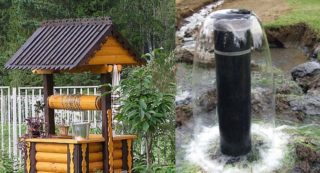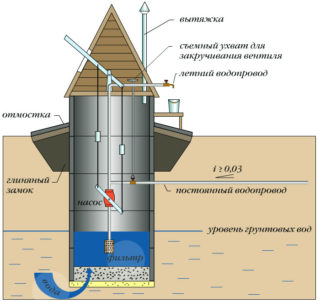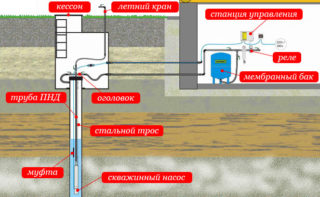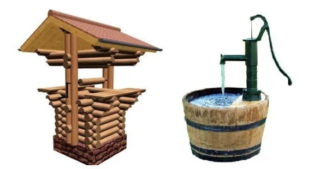To arrange an autonomous water supply in a suburban area, it is necessary to install an individual source - a well or a well. Each of them differs in a number of its pros and cons. Therefore, the choice is only up to the master according to the list of criteria important for him.
Brief comparative analysis of a well and a well

Structurally, both sources differ from each other. A well is a narrow shaft with a diameter of 70 mm to 130 mm. Its depth can reach 250 meters. For wells with a depth of 50 m or more, a special license is required. This is already an artesian spring with mineral water. The resource is extracted using downhole pumping equipment.
The well is a wider shaft from 70 cm with a depth of up to 15 m. From such an autonomous source, water can be raised using surface or submersible pumps, or manually.
The quality of the resource from the well and the well is always different. Water in the first comes from the upper strata. This means that it can be contaminated with industrial effluents, nitrates, bacteria and waste microorganisms. Fluid from the well often comes with an admixture of a large amount of minerals, heavy metal salts, iron, sand. But it is still the best.
Advantages and disadvantages

To understand which is better - a well or a well in the country, you should outline their pros and cons.
Well
It has the following main advantages:
- lower costs for arranging the source;
- the possibility of self-service and repairs if necessary;
- clear operation;
- no need to use special equipment on the site when installing the source.
The disadvantages of a well include:
- lower productivity (approximately 1-2 m3 / h) in comparison with the well;
- dubious water quality (depending on the location of the suburban area);
- drop in production during the heat season;
- the need for regular cleaning and disinfection.
Well water depends on rainfall. Often, an aquifer resource is mixed with groundwater.
Well

The deeper source has the following advantages:
- quick installation using special equipment;
- better fluid quality;
- takes up little space on the site;
- high productivity (3-5 m3 / hour).
The disadvantages of the source include:
- difficulty in maintenance or repair;
- the need to use expensive downhole pumping equipment;
- financial costs for the well construction;
- the complexity of its installation on quicksand;
- the risk of getting into highly mineralized water;
- the need to install good filtering equipment.
It is unlikely that it will be possible to independently drill a well on the site. Here it is necessary to conduct geological surveys and an exclusively professional approach.
Key differences in important parameters
- Verkhovodka. This is the smallest option for organizing the source. The seam depth is 4-5 meters.The simplest Abyssinian well (needle-well) is made at this level. The water here is of the lowest quality, since it absorbs all the upper drains.
- Subsoil. It is located approximately at the level of 10-13 meters. The liquid is cleaner here due to the passage of multilevel natural filtration (sandy, limestone, clayey layers).
- Artesian layers. Localized below 40 m. This resource is considered the purest and most drinkable.
It is better to make a well to a depth of more than 10 meters. Then you can safely use the building for economic and domestic purposes.
Source cost
Drilling a well will cost a little less if reinforced concrete rings are used when constructing a well. Moreover, for the installation of each subsequent (after 10 pcs.) You will have to pay extra from above. The borehole meter does not change depending on the depth of the source.
It is worth considering that you can use your own strength to install the well, while only specialists can drill the well. And this is a big cost.
Source stability
As for the flow rate, it is less constant for a well than for a well. Especially if the first one is dug on the top. Here, the water level will constantly drop in the event of a summer drought.
Volatility
A well is more profitable here, since water can be taken from it both with a pump and manually. From the well, the liquid is raised only with the help of injection equipment. To provide a house with water from their wells in the absence of electricity, you will have to install either an autonomous generator or a large accumulative accumulator. And these are additional costs.
Service life of sources
Both the well and the well are capable of operating for more than 20-25 years if they are properly constructed. However, they can fail under unfavorable conditions. Here the odds are completely equal. There are no differences in terms of operation.
How to choose the type of source

What is better for private houses - a well or a well, the master determines based on the following criteria:
- Purpose of using water. If it is needed only for summer cottages (watering, irrigation, washing), it is more convenient to build a small water well or an igloo well. For drinking, it is better to mount a deeper source.
- Seasonality of use of a well or well. If you intend to permanently reside in the house, it is better to mount a deeper, more solid hydraulic structure. For summer use of water, a well with a depth of 8-12 meters will be enough.
- The depth of the formation at the site. If it is located below the 15 m mark, it is better to drill a well. Digging a well to such a depth and then equipping it is impractical.
- Finance. Well construction is cheaper than well installation.
- Technical difficulties. When installing the well, it will be necessary to "pat" the already landscaped area. In turn, digging a well is an impressive volume of the selected soil, which needs to be attached somewhere.
In order to finally determine the type of source on the site, it is advisable to bypass the neighbors, find out what is the depth of their wells and wells and how things are with the flow rate in the summer. The services of professionals will be useful. Pre-drilling is a cost. But experts will determine the type of source required for the specific purposes and capabilities of the site.
Owner reviews
Judging by the feedback from the owners, each type of hydraulic structure is good for specific situations.
Nikolay, 43 years old. Personally, I bought a house with a well. Its depth was ridiculous - about 8 m. The quality of the water is not at all. There was also a smell. I didn't choose for a long time and decided to drill. He invited specialists. Identified the nearest aquifer with good water at 28 meters. The drilling took a day. Then pumping the source. Everything took no more than a week with the arrangement and installation of pumping equipment. The well has been in production for the third year already. Productivity - about 4 m3 / hour. A house of two floors plus a garden is supplied from this building.The difference in water quality is enormous, of course.
Yura, 39 years old. I have a country house with one room and a kitchen. We often use it as a summer boarding house. There is no running water to the village, so everyone made their own springs. Some have a well, some have an Abyssinian. I decided to try the second option. Drilled independently with a drill 8 meters and reached the aquifer. I put a narrow pipe with a filter. I preserve the system for the winter.
Ilya, 35 years old. The well decided to dig on the site as soon as he bought it. Followed the example of the neighbors. They dug together with the godfather to a depth of 12 meters. Kept within 10 concrete rings. The rest was laid out with bricks (remained from the old house). The water comes in clean (handed over for analysis). There is a small admixture of sand and metal salts. But for drinking I put a reverse osmosis installation. There is water all the time, even in the heat of the summer. The well has been in operation for the fourth year already.









